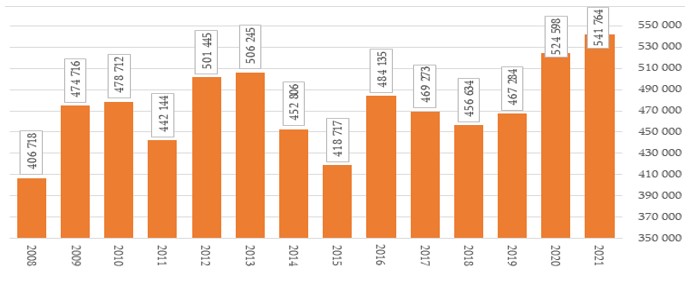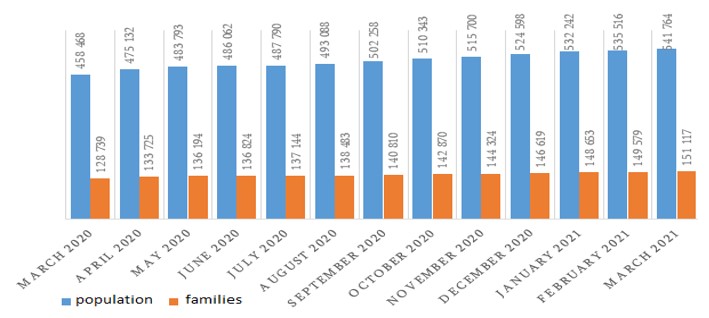Mamuka Khazaradze: “The number of social benefit recipients stands at a historic high.”
Verdict: FactCheck concludes that Mamuka Khazaradze’s statement is TRUE.
Resume: In accordance with the Social Service Agency, the number of socially vulnerable persons is indeed at a historic high. In March 2021, 541,764 individuals (151,117 families) collected cash social payments.
Amid the pandemic, the number of persons registered in the database of socially vulnerable people increased by 110,804 (32,003 families) in March 2021 as compared to March 2020. Of these, the number of cash social payment recipients increased by 83,296 (22,378 families).
The growth of subsistence benefit recipients is mostly stipulated by the increased number of applications from people (to register in the database of socially vulnerable people) which in turn was spurred by the pandemic induced socio-economic crisis. On the other hand, the expansion of the targeted social assistance programme – as part of the anti-crisis plan – for already registered socially vulnerable people also affected the growth of subsistence benefit recipients to some extent. [1]
Analysis
Mamuka Khazaradze, the leader of the Lelo for Georgia political party, stated: “The number of social benefit recipients stands at a historic high.”
The cash social benefit (subsistence benefit) government programme aims to provide cash payments and other assistance to families below the poverty line. A family’s socio-economic situation is measured by a relevant methodology which determines the family’s rating points. The amount of cash payments and other benefits are established on the basis of the rating points.
In accordance with the Social Service Agency, 541,764 individuals (151,117 families) collected cash social payments (subsistence benefits) in March 2021. In 2008-2021, the highest number of socially vulnerable people was registered in March 2021).
Graph 1: Highest Number of Subsistence Benefit Recipients in 2008-2021

Source: Social Service Agency
Amid the pandemic, the number of persons registered in the database of socially vulnerable people increased by 110,804 (32,003 families) in March 2021 as compared to March 2020. Of these, the number of cash social payment recipients increased by 83,296 which is 22,378 families.
In the last year, the targeted social assistance programme was expanded as part of the anti-crisis plan to alleviate the socio-economic damage from the pandemic and the respective restrictions. Therefore, the number of recipients also increased. In the period of May to October 2020, GEL 600 payments were disbursed (GEL 100 on average, based on the number of family members) to families registered in the joint database of socially vulnerable families whose rating points were from 65,000 to 100,000. This assistance was paid to 79,158 families. In addition, large families (with three and more children under the age of 16 years) whose social rating points were between 0 and 100,000 also received GEL 100 payment for six months (May to October) amid the pandemic. Prior to the pandemic, social assistance for families with 65,000 to 100,000 rating points was paid only for children under the age of 16. As a part of the fourth phase of the anti-crisis plan, families with 65,000 to 100,000 rating points and large families have continued to collect the aforementioned payments since January 2021 (for six months).
The growth of socially vulnerable people (those collecting subsistence benefits) is somehow related to the expansion of the programme amid the pandemic. However, the number families and people collecting subsistence benefits also increased in November-December 2020 when cash payments envisioned under the anti-crisis plan were not made.
Graph 2: Number of Families and People Collecting Subsistence Benefits, March 2020 – March 2021

Source: Social Service Agency
Generally, the number of subsistence benefit recipients constantly changes and can increase or decrease. Social assistance recipient families are regularly verified for geographic, demographic or income changes. Moreover, new beneficiaries are added to the programme. The changes in the methodology to measure the socio-economic situation of socially vulnerable families significantly affect the number of subsistence benefit recipients. The growth in the number of socially vulnerable persons in 2020-2021 is directly linked with the pandemic-induced socio-economic crisis.
[1] As a result of the expansion of the programme, some people who were registered in the database prior to the programme’s expansion and who did not meet the necessary criteria to collect subsistence benefits subsequently became eligible for the aid.








